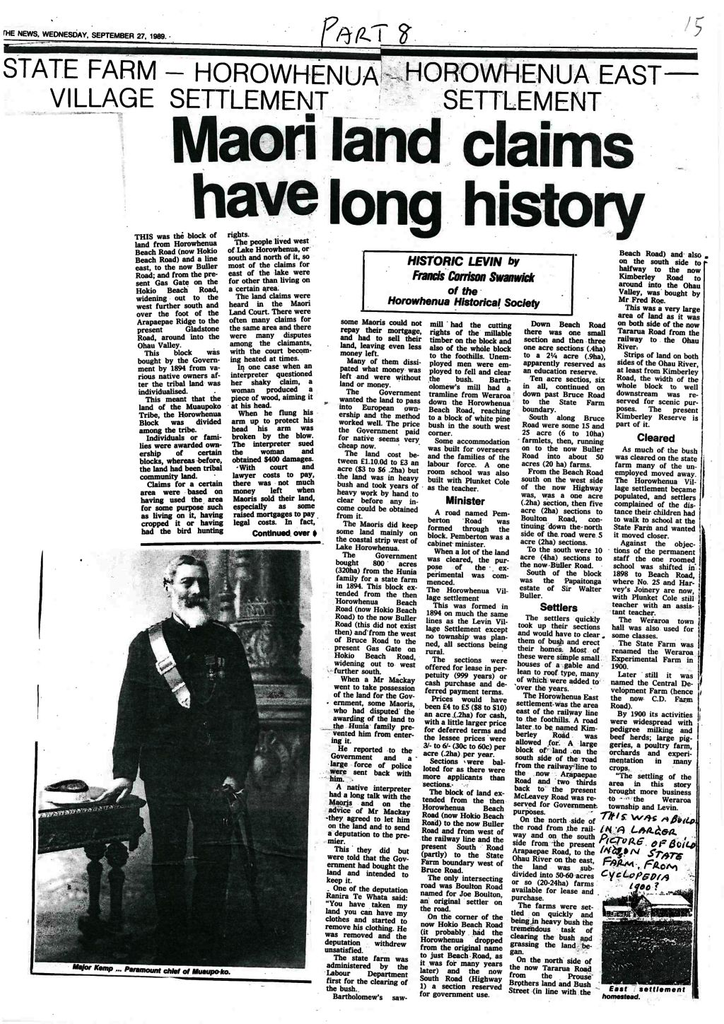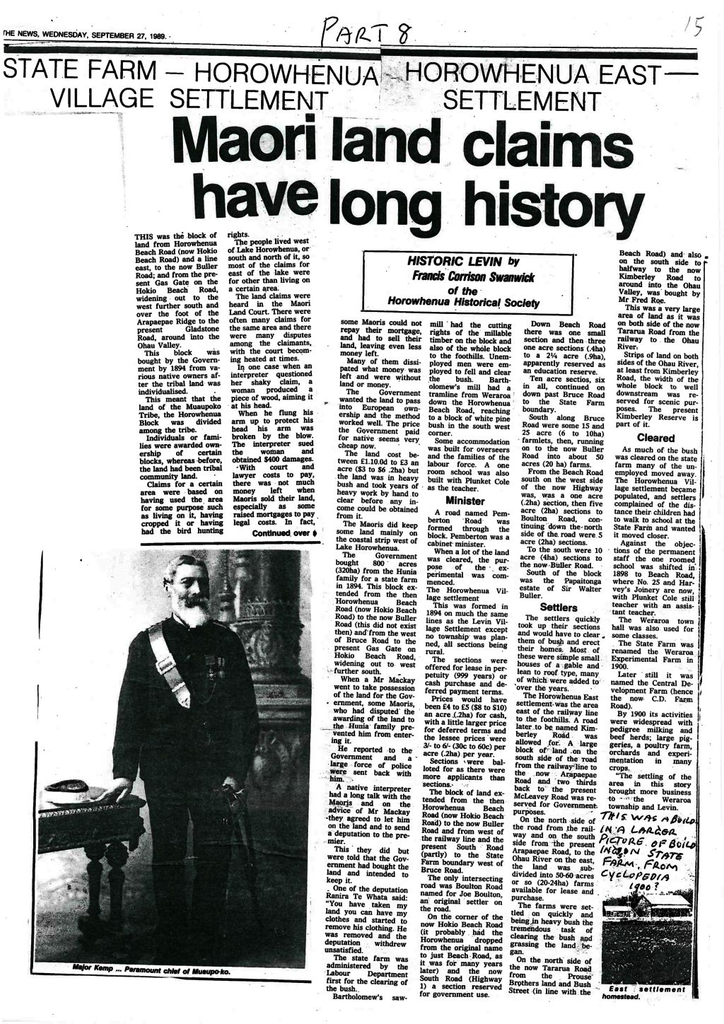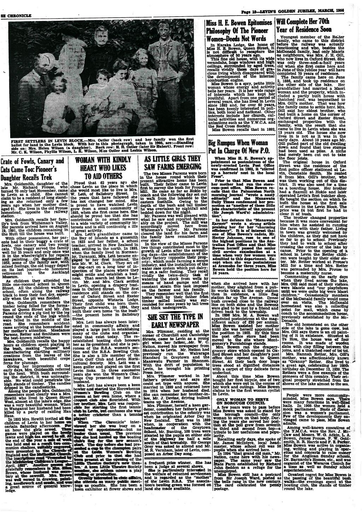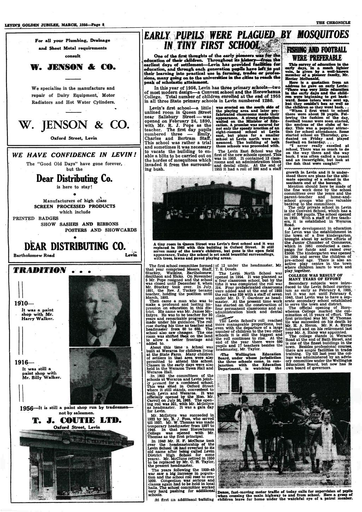Maori land claims have long history
- Description
This text that follows is the content of the attached PDF.
State Farm – Horowhenua East Village SettlementThis was the block of land from Horowhenua Beach Road (now Hokio Beach Road) and a line east, to the now Buller Road; and from the present Gas Gate on the Hokio Beach Road, widening out to the west further south and over the foot of the Arapaepae Ridge to the present Gladstone Road, around into the Ohau Valley.
This block was bought by the Government by 1894 from various native owners after the tribal land was individualised.
 This meant that the land of the Muaupoko Tribe the Horowhenua Block was divided among the tribe.
This meant that the land of the Muaupoko Tribe the Horowhenua Block was divided among the tribe.Photo at left shows Major Kemp - of the Muaupo-ko.
Individuals or families were awarded ownership of certain blocks, whereas before, the land had been tribal community land.
Claims for a certain area were based on having used the area for some purpose such as living on it, having cropped it or having had the bird hunting rights.
The people lived west of Lake Horowhenua, or south and north of it, so most of the claims for east of the lake were for other than living on a certain area.
The land claims were heard in the Maori Land Court. There were often many disputes among the claimants, with the court becoming heated at times.
In one case when an interpreter questioned her shaky claim, a woman produced a piece of wood, aiming it at his head.
When he flung his arm up to protect his head, his arm was broken by the blow. The interpreter sued the woman and obtained $400 damages.
With court and lawyer costs to pay, there was not much money left when Maori sold their land, especially as some raised mortgages to pay legal costs. In fact some Maori could not repay their mortgage. And had to sell their land leaving even less money left.
Many of them dissipated what money was left and were without land and money.
The Government wanted the land to pass into Europeanownership and the method worked well. The price the Government paid for native seems very cheap now.
The land cost between 1.10.0 pounds to 3pounds an acre ($3 to $6 .2ha) but the land was in heavy bush and took years of heavy work by hand to clear before any income could be obtained from it.
The Maori did keep some land mainly on the coastal strip west of Lake Horowhenua.
The government bought 800 acres (320ha) from the Hunia family for a state farm in 1894. This block extended from the then Horowhenua Beach Road, widening out to west further south.
When Mr Mackay went to take possession of the land for the Government, some Maori, who disputed the awarding of the land to the Hunia family, prevented him from entering it.
He reported to the Government and large forces of police were sent back with him.
A native interpreter had a long talk with the Maori and on the advice of Mr Mackay they agreed to let him on the land and to send a deputation to the premier.
This they did, but were told that the Government had bought the land and intended to keep it.
One of the deputation Ranira Te Whata said; ‘You have taken my land, you have taken my clothes' and started to remove his clothing. He was removed and the deputation withdrew unsatisfied.
The state farm was administered by the Labour Department first for the clearing of the bush.
Bartholomew’s saw mill had the cutting rights of the millable timber on the block and also of the whole block to the foothills. Unemployed men were employed to fell and clear the bush. Bartholomew’s mill had a tramline from Weraroa down the Horowhenua Beach Road, reaching to a block of white pine bush in the south west corner.
Some accommodation was built for overseers and the families of the labour force. A one-room school was also built with Plunket Cole as the teacher.
Minister
A road named Pemberton Road was formed through the block; Pemberton was a cabinet minister.
When a lot of the land was cleared, the purpose of the experimental farm was commenced.
The Horowhenua Village Settlement
This was formed on 1894 on much the same lines as the Levin Village Settlement except no township was planned, all sections being rural.
The sections were offered for lease in perpetuity (999 years) or cash purchase and deferred payment terms.
Prices would have been 4 pounds to 5 pounds ($8 to $10) an acre (2ha) for cash, with a little larger price for deferred terms and the lessee prices were 3/-to6/ (30c to 60c) per acre (2ha) per year.
Sections were balloted for as there were more applicants than sections.
The block of land extended from the then Horowhenua Beach Road now Buller Road and from west of the railway line and the present South Road (partly) to the State Farm boundary west of Bruce Road.
The only interesting road was Boulton Road named for Joe Boulton, an original settler on the road.
On the corner of the now Hokio Beach Road (it probably had the Horowhenua dropped from the original name to just Beach Road, as it was for many years later) and the now South Road (Highway 1) a section was reserved for Government use.
Down Beach Road there was one small section and then three one acre sections (.4ha) to a 2 ¼ acre (.9ha), apparently reserved as an education reserve.
Ten acre sections, six in all, continued on; down past Bruce Road were some 15 and 25 acre (6 to 10ha) farmlets, then, running on to now Buller Road into about 50 acres (20ha) farms.
From Beach Road south on the west side of the now Highway was, a one acre (.2ha) section, then five acre (2ha) sections to Boulton Road, continuing down the north side of the road were 5 acre (2ha) sections.
To the south were 10 acre (4ha) sections now Buller Road.
South of the Block was the Papaitonga estate of Sir Walter Buller.
Settlers
The settlers quickly took up their sections and would have to clear their homes. Most of these were simple small houses of a gable and lean to roof type, many of which were added to over the years.
The Horowhenua East settlement was the area east of the railway line to the foothills. A road later to be named Kimberly Road was allowed for. A large block of land on the south side of the road from the railway line to the now Arapaepae Road and two thirds back to the present McLeavey Road was reserved for Government purposes.
On the north side of the road from the railway and on the south side from the railway and on the south side from the present Arapaepae Road to the Ohau River on the east, the land was subdivided into 50-60 acres or so (20-24ha) farms available for lease and purchase.
Settlers
The farms were settled on quickly and being in heavy bush the tremendous task of clearing the bush and grassing the land began.
On the north side of the now Tararua Road from the Prouse Brothers land and Bush Street (in line with the Beach Road) and also on the south side to halfway to the now Kimberley Road to halfway into the Ohau Valley, was bought by Mr Fred Roe.
This was a very large area of land as it was on both sides of the now Tararua Road from the railway to the Ohau River.
Strips of land on both sides of the Ohau River, at least from Kimberley Road, the width of the whole block to well downstream was reserved for scenic purposes. The present Kimberley Reserve is part of it.
Cleared
As much of the bush was cleared on the state farm many of the unemployed moved away. The Horowhenua Village settlement became populated, and settlers complained ofthedistance their children had to walk to school at the State Farm and wanted it moved closer.
Against the objections of the permanent staff the one-roomed school was shifted in 1898 to Beach Road, where No. 25 and Harvey’s Joinery are now, with Plunket Cole still teacher with an assistant teacher.
The Weraroa town hall was also used for some classes.
 The state farm was renamed the Weraroa Experimental Farm in 1900.
The state farm was renamed the Weraroa Experimental Farm in 1900.Later still it was named the Central Development Farm (hence the now C.D. Farm Road).
By 1900 its activities were widespread with pedigree milking and beef herds, large piggeries, a poultry farm, orchards and experimentation in this story brought more business to the Weraroa Township and Levin.
Identification
- Date
- September 27, 1989
Taxonomy
- Community Tags




